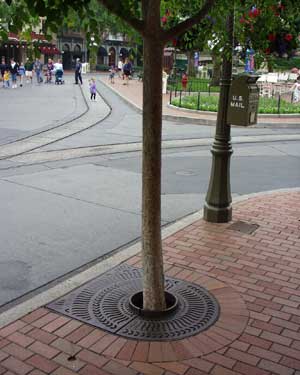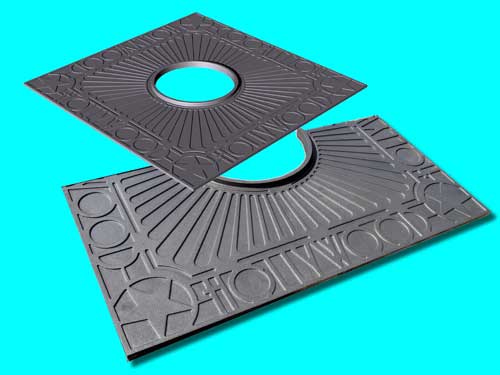Pedestrian Friendly: Planting Trees and Celebrating Stormwater in Urban Areas
Custom Design: Site-Specific Solutions, Aesthetics and Branding
Besides providing solutions for healthy tree plantings in the built environment, tree grates are also a design element. By the nature of the production process cast metals permit and even invite design innovation that can enhance a sense of place. Corporate or city logos can be incorporated into the castings to provide a branding element for the space. Special sizes and shapes can be cast to reflect or coordinate with surrounding flat work or building elements. For example, in addition to the standard square, round, and rectangular shapes, triangles, arcs and diamonds have also been used as part of a sidewalk design element.
Case Study: Theme Park Design Branding |
||
|

Slotless custom tree grate at a theme park. If an area needs to be washed down frequently, this tree grate is designed to capture the water before it reaches the tree root sending it to infiltration systems and/or storm drains. Photo courtesy of IRONSMITH |
|
 |
||
The grate shown at top is a computer generated rendering from 3D design software. The grate shown at bottom is an actual photo of a completed grate panel. The lower image shows the gray color of cast iron before it starts to develop a patina. Photo courtesy of IRONSMITH |
||
Â
Sustainable Design:Â Materials and Durability
Main street sidewalks, indoor malls, downtown business districts are horizontal surfaces with a lot of pedestrian traffic. The wear and tear on the walking surface can include damage from foot traffic, dining furniture, heat lamps, bicycles, baby carriages as well as from cleaning, road salt, snow clearing and maintenance crews.   Metal products for all street applications should be durable. Typical metal products used for outdoor wear include recycled cast gray iron, aluminum or bronze. Most steel construction shapes are made from 75 percent recycled product and are 100 percent recyclable.  Cast products can be specified for LEED® credits to be made from 100 percent recycled product and are 100 percent recyclable. There is very little difference in durability, between cast iron, bronze or aluminum and the designer usually chooses a product, based on the design aesthetic and/or budget. Special alloys of aluminum and bronze can also be requested of a manufacturer. Most grate frames and tree guards are fabricated from steel.
Natural or unfinished gray iron develops an attractive rust patina that does not penetrate or weaken the casting and is maintenance free. Natural aluminum will age to a pewter gray and when provided with a brushed finish, can approximate the look of stainless steel at significantly less cost. .  Designers can also specify an array of factory finishes; primed  and painted in an exterior enamel, primed and painted an exterior polyurethane, powder coatings, and/or  with a zinc undercoating. Paint finishes can be matched to any color choice. Industrial paints are recommended for enamel or polyurethane finishes.   Polyurethane finishes will hold up to foot traffic much better than enamel and are far less likely to fade due to solar UV exposure. Â
One of the disadvantages of "wet finishes" such as enamel and Polyurethane paints is their volatile organic compound content (VOC). Powder coating is the application of an electrostatic charged dry powder baked onto a surface. Select a powder coat color that is available in a polyester base for good weather-ability and do not use epoxy coatings. For heavily trafficked surfaces and outdoor surfaces, particularly in harsh winter climates, powder coating is more durable than either enamel or polyurethane finishes and will require less maintenance. Cast iron is extremely susceptible to rust and even when well painted or coated, some rust should be expected. For this reason the following guidelines should be used when specifying finishes for cast products. Â
- Use only dark colors; black, dark brown, dark green, dark gray, etc.
- If light colors are required, specify a zinc undercoat to help reduce rust bleed through.
- When no rust can be tolerated, specify cast aluminum.
In urban areas with heavy pollution, in cold climates where there is snow removal using salt and in humid climates which are near the ocean, specify unfinished or painted aluminum or unfinished cast iron with the rust patina not painted cast iron. New rust is bright orange which will naturally rust to a dark brown; however, there are liquid products which can be applied to accelerate the darkening of the patina.  Darker patina's can be achieved by applying a low grade asphalt product that is absorbed into the steel.
Too much watering, salt snow melt applications and power washing are man-made elements which in urban setting can harm a tree's growth. Without enough water, or with too much water, a tree will have a hard time surviving in the urban environment.  Besides assuring that the tree is planted with enough root space, the designer can choose tree grates which provide irrigation below the grate and protect the tree from too much water.









